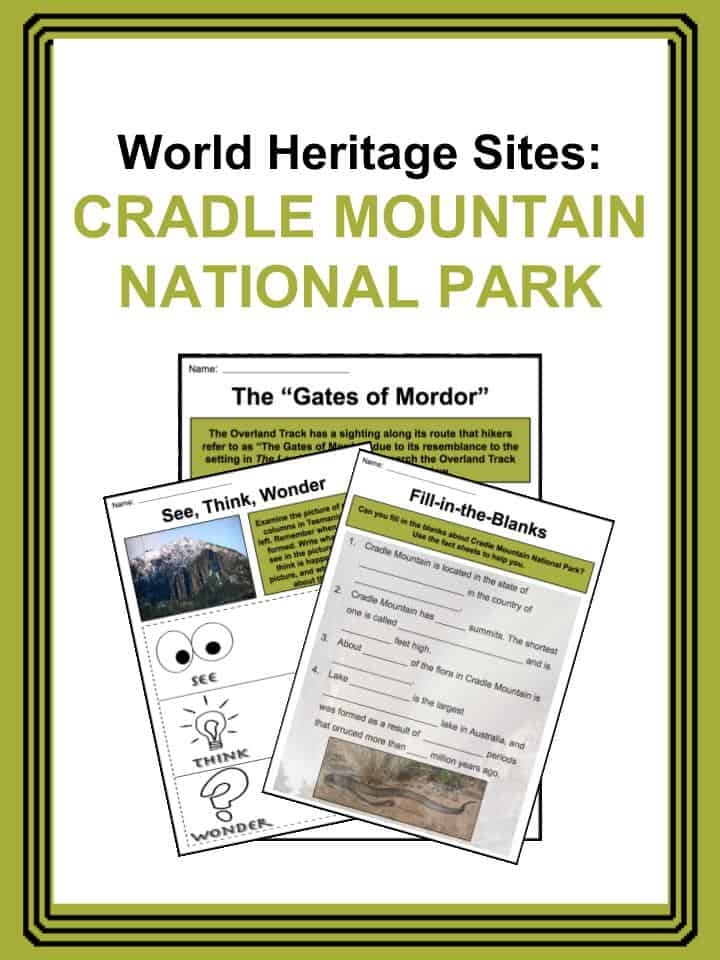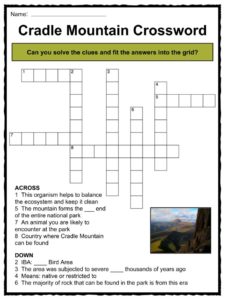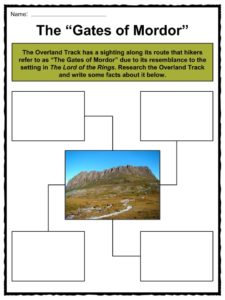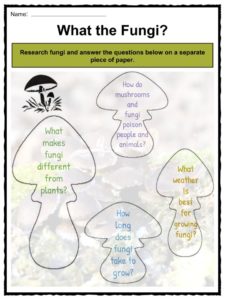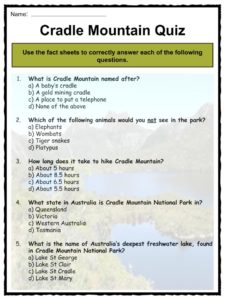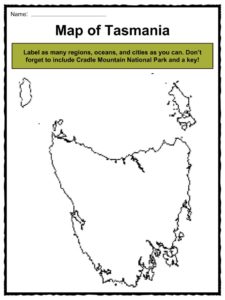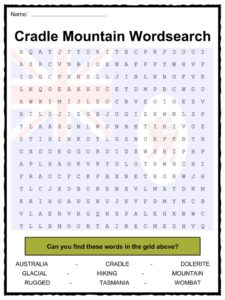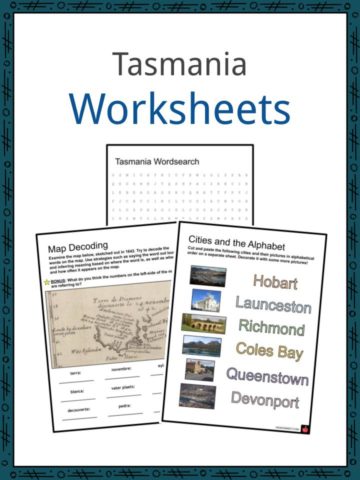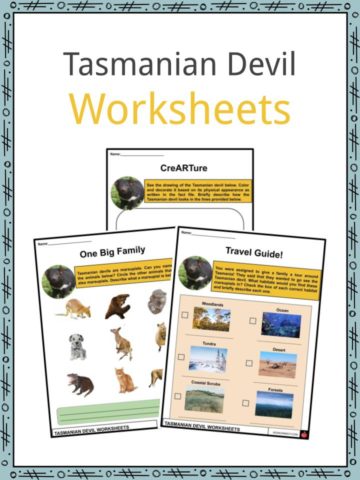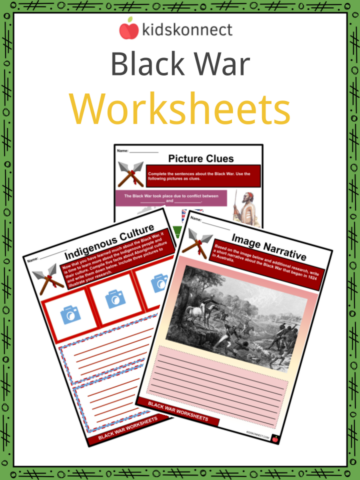Download This Sample
This sample is exclusively for KidsKonnect members!
To download this worksheet, click the button below to signup for free (it only takes a minute) and you'll be brought right back to this page to start the download!
Sign Me Up
Cradle Mountain is located in the Central Highlands of Tasmania (a state in Australia). It is situated in Cradle Mountain National park, and includes Lake St. Clair. It became a UNESCO World Heritage Site in 1982 and was extended in 1989.
See the fact file below for more information on Cradle Mountain or alternatively, you can download our 22-page World Heritage Sites: Cradle Mountain worksheet pack to utilize within the classroom or home environment.
Key Facts & Information
History and Geology
- Cradle Mountain is situated in Cradle Mountain National park in Tasmania, an island south of Australia. The mountain forms the north end of the entire national park.
- The first Europeans to explore and summit Cradle Mountain were Henry Hellyer and Joseph Fossey, who were surveying in Tasmania in 1827 and 1828.
- Trappers worked in the area from the 1860s until the 1950s, which is when the fur trade collapsed.
- James Smith forested vast tracts from 1863, and the area was logged until the 1910s.
- Cattle and sheep grazed in Cradle Valley from 1910 to 1930.
- The area was declared a wildlife reserve in 1927 and a national park in 1947.
- Cradle Mountain is named after its resemblance to a gold mining cradle (an old implement used when mining gold by hand).
- Remains found in caves scattered within Cradle Mountain and Tasmania as a whole dictate that human occupation of the area goes back more than 20,000 years.
- The area was subjected to severe glaciation thousands of years ago, and the mountain itself was formed over Dove Lake, Lake Wilks, and Crater Lake.
- Cradle Mountain shows geological evidence of 3 different glacial stages that took place over the span of the last 2 million years.
- The National Park also boasts Tasmania’s highest mountain, Mt. Ossa, which is known for its Jurassic Dolerite peaks. Jurassic Dolerite refers to the igneous rock that formed during the Jurassic Period in Tasmania.
- Cradle Mountain has four summits that have been named. They are, in order of height
- Cradle Mountain 5,069 ft (1,545 m)
- Smithies Peak 5,010 ft (1,527 m)
- Weindorfers Tower 4,787 ft (1,459 m)
- Little Horn 4,446 ft (1,355 m)
- These peaks are climbed year-round by avid hikers and outdoor enthusiasts.
- Cradle Mountain is one of the main tourist sites in Tasmania.
- It became a UNESCO World Heritage Site in 1982 and was extended in 1989.
Geography and Climate of Cradle Mountain
- Lake St. Clair is part of Cradle Mountain-Lake St Clair National Park.
- It is Australia’s deepest natural freshwater lake, with an area of approximately 17 sq mi (45 sq km) and a depth of 705 ft (215 mt).
- The lake itself is a result of the occurrence of glacial periods over the last 2 million years.
- Cradle Mountain National Park experiences a typical southern hemisphere climate, where the summer is cold, and the winter is hot.
- The rainy season at the park is between July and September, with some months receiving over 9 inches of rain (nearly 30 cm).
- Due to its jagged contours, Cradle Mountain gives off a rugged, wild feel and the rainforest and heathlands provide a wide variety of environments, flora, and fauna to explore.
- Hikers will come across icy streams that flow from the mountains, pine trees, and pristine waters from glacial lakes.
- The mountain itself is composed of a variety of rock types and soils.
Flora and Fauna
- Cradle Mountain is covered with ancient rainforests and alpine and subalpine vegetation, including varieties of Tasmanian eyebright, scoparia heath, mountain rocket, and a variety of pine trees.
- There is a wide variety of fungi that grow in the park, and they work to benefit the ecosystem by recycling organic matter and breaking down fallen branches and leaves.
- Walking/hiking around Cradle Mountain, you would likely encounter wombats, Tasmanian devils, and echidnas.
- The highly venomous tiger snake is also found in the area.
- Look carefully, and you can also spot pink robins, peregrine falcons, and many other beautiful species of birds.
Did You Know Facts about Cradle Mountain
- The main tourist hubs in the park are Cradle Mountain Village and Derwent Bridge.
- The national park is a prime location for Australia’s endemic (meaning native or restricted to) species.
- Around half of the alpine flora in the park is endemic, meaning it only grows in that area in Australia and nowhere else in the world.
- The vegetation in the park is very diverse and has been fortunate to escape the forest fires that have damaged other parts of Tasmania.
- The park is important for the 11 endemic bird species in Tasmania, and it has been identified as an IBA (Important Bird Area).
- Although many people in Australia view fungus as a problem, it is actually crucial to the survival of the ecosystems in Tasmania.
- The documentary on the Discovery Channel titled “When Dinosaurs Roamed America” was filmed partially in Cradle Mountain National Park.
- The mountain is open to climbers year-round, and most hikers take the Overland Track, which is one of Australia’s most famous hiking tracks.
- It takes experienced hikers about 6.5 hours to climb Cradle Mountain. Some parts involve tricky boulders, slippery slopes, snow-covered holes, and rough terrain.
- From the summit, hikers can see Dove Lake, Barn Bluff, and Mount Ossa.
- Cradle Mountain is the 5th highest mountain in Tasmania.
- Bad weather is known to arrive swiftly in the area, causing treacherous hiking conditions.
World Heritage Sites: Cradle Mountain Worksheets
This is a fantastic bundle that includes everything you need to know about Cradle Mountain across 22 in-depth pages. These are ready-to-use World Heritage Sites: Cradle Mountain worksheets that are perfect for teaching students about Cradle Mountain which is located in the Central Highlands of Tasmania (a state in Australia). It is situated in Cradle Mountain National Park and includes Lake St. Clair. It became a UNESCO World Heritage Site in 1982 and was extended in 1989.
Complete List Of Included Worksheets
- Cradle Mountain Facts.
- Cradle Mountain Crossword.
- The “Gates of Mordor”.
- What the Fungi?
- Cradle Mountain Quiz.
- Map of Tasmania.
- Cradle Mountain Wordsearch.
- Redesign the Tasmanian Flag.
- Fill-in-the-Blanks.
- Cradle Mountain Acrostic.
- See, Think, Wonder.
Frequently Asked Questions
What makes Cradle Mountain so special?
Cradle Mountain is special because it is synonymous with natural wilderness. An abundance of wildlife makes Cradle Mountain a spectacular national park to visit.
One can encounter the unique Tasmanian devils, platypus (semi-aquatic mammals), Quolls (native cats ), wombats, and the highly inquisitive black currawong.
How old is Cradle Mountain?
The Cradle Valley in Tasmania, Australia, was carved out by glacial ice action about 20,000 years ago. Around 10,000 years ago, the ice melted, revealing what we can now see.
Is Cradle Mountain the highest mountain in Australia?
Tasmania is Australia’s most mountainous state. It has thirty peaks higher than 1,200 m (3,937 ft), and it is one of the most mountainous islands in the world.
Are there reptiles at Cradle Mountain?
Tasmania is home to a number of reptiles that are mainly active during the warm summer months. There is the Tasmanian tree frog, the moss froglet, and the Tasmanian froglet. There are also a variety of lizards in Tasmania, which with the exception of the mountain dragon, are all skinks.
What poisonous animals live in Tasmania?
Tasmania has three poisonous snakes. Copperheads, tiger snakes, and white-lipped snakes are all venomous.
Does Cradle Mountain get snow?
Cradle Mountain’s summit is over 5,000 ft (over 1,500 m) above sea level, and the peak receives snowfalls in the winter months from July to September.
Link/cite this page
If you reference any of the content on this page on your own website, please use the code below to cite this page as the original source.
Link will appear as Cradle Mountain Facts & Worksheets: https://kidskonnect.com - KidsKonnect, July 12, 2018
Use With Any Curriculum
These worksheets have been specifically designed for use with any international curriculum. You can use these worksheets as-is, or edit them using Google Slides to make them more specific to your own student ability levels and curriculum standards.
